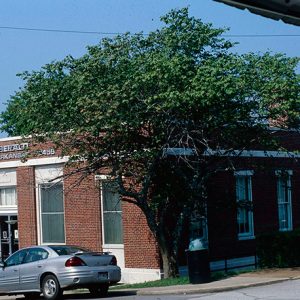calsfoundation@cals.org
Pocahontas Post Office (Historic)
The historic Pocahontas Post Office is a one-story, brick-masonry building built between 1936 and 1937. Located a few blocks away from the historic downtown square of Pocahontas (Randolph County), this building served as the post office for the area until 1986, when post office operations moved to new facilities. The old post office was built in the Art Deco style, which was a common form of architecture for Works Progress Administration (WPA) post offices at that time. This style of architecture is represented by vertical pilasters and brick segments with stylized ornamental decorations within the pilasters.
Pocahontas got its first post office after the town was voted the Randolph County seat in 1835. By 1936, that original post office building had deteriorated, and postal operations were housed in the Spinnenwebber Building. The construction of the next post office was supervised by the WPA under the direction of F. L. Rice, a Treasury Department construction engineer. Construction began in 1936 by the T. Jarvis and Company of St. Louis, Missouri, for a cost of $51,684; the building was completed the following year.
Local boosters with the Pocahontas Chamber of Commerce, in conjunction with U.S. senator Joe T. Robinson, lobbied to host Postmaster General James E. Farley for the grand opening of the Pocahontas Post Office in 1937. Due to a scheduling conflict, however, Farley was not able to attend. Nevertheless, the Pocahontas Post Office opened for business on July 13, 1937. The new offices included modern equipment such as tumbler locks to increase consumer security.
Many Arkansas post office buildings constructed by the WPA during the Depression, including the Pocahontas Post Office, featured murals. The Treasury Department’s Section of Painting and Sculpture (later renamed the Section of Fine Arts) administered this aspect of construction and chose Louis Freund to paint the mural at the post office. Freund visited Pocahontas in 1939 to gather historical information for his mural. Titled Early Days of Pocahontas, it includes elements of life in Davidsonville (Lawrence County) in the early 1800s, the early dam and mill site at Birdell (Randolph County) on the Eleven Point River, boat traffic on the Black River at Pocahontas, and downtown scenes of Pocahontas around 1900. After it suffered some deterioration, the mural was removed from around the postmaster’s door. It has been restored and is on display at the Arkansas State University Museum.
In the twenty-first century, the 1937 Pocahontas Post Office building houses offices for the local newspaper, the Pocahontas Star-Herald. The original front door has been replaced, but despite this, the building retains a high degree of historical integrity. The historic Pocahontas Post Office was listed on the National Register of Historic Places on May 16, 2002.
For additional information:
“Arkansas Post Office Murals.” University of Central Arkansas. http://uca.edu/postofficemurals/home/ (accessed September 17, 2019).
“Arkansas Post Office Murals: Pocahontas.” University of Central Arkansas. http://www.uca.edu/postofficemurals/pocahontas/ (accessed September 17, 2019).
Gill, John Purifoy. Post Masters: Arkansas Post Office Art in the New Deal. Jonesboro: Arkansas State University Foundation, 2002.
“Pocahontas Post Office.” National Register of Historic Places nomination form. On file at Arkansas Historic Preservation Program, Little Rock, Arkansas. Online at http://www.arkansaspreservation.com/National-Register-Listings/PDF/RA0018.nr.pdf (accessed September 17, 2019).
United States Postal Service. History of Post Office Construction, 1900–1940. Washington DC: U.S. Postal Service, 1982.
Zachary Elledge
Jonesboro, Arkansas
 Pocahontas Post Office
Pocahontas Post Office 




Comments
No comments on this entry yet.